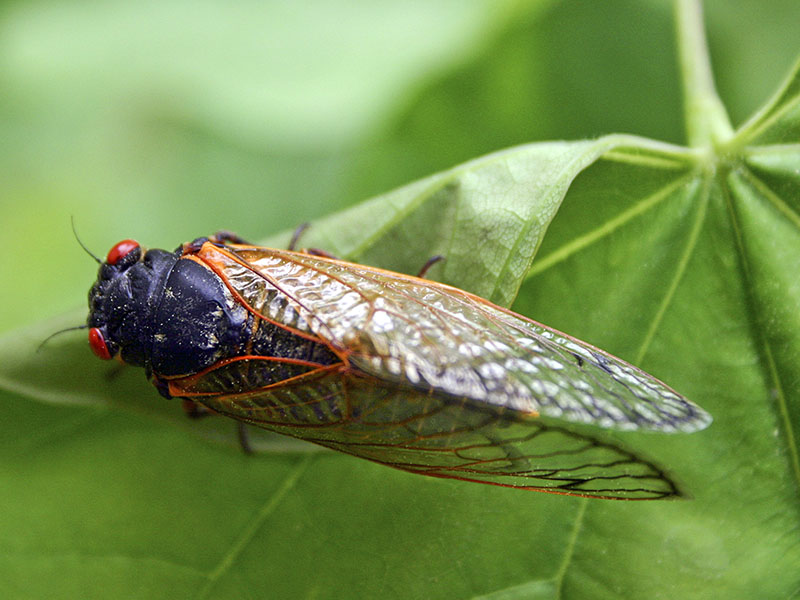After 14 months of a strange way of life with smaller gatherings and face masks in public, the Washington, D.C. metropolitan area has entered another strange phase – the arrival of the cicadas! For the first time in 17 years, people are spotting cicadas on trees, lawns and small structures close to the ground. Cicadas are fairly large insects that span roughly two inches in length. They have gigantic red eyes and clear wings, giving them an almost cartoonlike appearance.
Not everybody is crazy about cicadas, pronounced SIH-KAY-DUZ. Many parents from local Facebook groups have expressed a range of emotions, spanning from disgust to the vomit emoji, anxiety and extreme fear. What is it about these insects that causes people to be afraid? Is there anything we can do to ease our discomfort? What about our children; how do we approach these odd insects with our littles?
Franjernera Brown from Fort Washington, Maryland, and her two children, ages 8 and 9, have an aversion to cicadas for different reasons. “ … [T]hey are bigger bugs than I’m used to contending with … I need to use muscle and bravery to get them out of my sight and imagination,” states Brown. Julie MacCartee from Chevy Chase, Maryland, and her two children, ages 5 and 1, have a deep appreciation for these once-in-a-blue-moon creatures: “I was 4 years old the first time I experienced them and I loved them!! Cicadas kicked off my lifetime love of insects. I think they are fascinating and beautiful,“ beams MacCartee.
There is no right or wrong opinion about cicadas. As parents, we should feel comfortable with our own and our children’s personal preferences. Regardless of our feelings, it’s a good idea to learn some basic information about cicadas to help us be less fearful.
Cicadas 101
According to the University of Maryland Extension, there are two types of cicadas. The annual cicada appears every summer and periodical cicadas appear every 13 to 17 years. Every group of cicadas is identified as a brood and is distinguished by geography and date of emergence. In 2021, the periodical cicadas, dubbed Brood X, began to emerge in the eastern states. They are comprised of three species, with Magicicada septendecim as the most dominant species in our area.
Cicada young, known as immature nymphs, go through a larval stage and live most of their lives underground eating sap from tree roots and developing through four growth spurts known as molts. At the end of their final growth spurt, mature nymphs emerge from the soil, shed their exoskeletons and become winged adult cicadas. The biological material left behind is known as exuviae.
Mature nymphs appear when the soil reaches 64 degrees Fahrenheit, starting at the end of April through the beginning of May. From the underground, they dig tiny holes in the soil and come out in large quantities, seeking vertical structures such as shrubs and trees. For approximately four weeks after emerging from the soil and shedding their exoskeletons, cicadas have mass mating events as an “evolutionary strategy to ensure their survival … ‘if we all come out at once, predators can’t eat us all,’ and it makes sure a species survives if not all the individuals do,” as a blog post on the Smithsonian magazine website puts it.
Male cicadas use drumlike tymbal organs on their abdomens to create mating “songs” which are loud and unique to each species, hoping to attract females and mate. The unusual sounds may resemble buzzing chainsaws or other loud machinery. After the mating process, the female uses her bladelike ovipositor to create small slits in freshly planted tree branches to deposit her eggs. Females can deposit as many as 600 eggs!
Approximately six weeks later, the eggs hatch and the immature nymphs drop down to the ground to burrow into the soil and begin feeding on the sap of tree roots. The life cycle of cicadas begins once again. The next wave of periodical cicadas is expected to show up in our area in 2038. Brood X is expected to be here momentarily and disappear by the beginning of July.
Follow-up and resources for parents
Since periodical cicadas appear in our area only once every 13 to 17 years, now is a perfect time to introduce our children to the biological and scientific beauty of these winged creatures.
Lisa Barney from Springfield, Virginia, has loved animals her entire life. She has instilled that love into her 14-year-old son Nicholas, who is “ … an animal/bug lover like me. The fact they are underground for so long just fascinates him.” Barney, who also teaches pre-K students at Longbranch Elementary School in Arlington, Virginia, is certain her kiddos will be scared of the cicadas, but she is excited and ready for the opportunity to gently introduce them with fun lesson plans. Jennifer Brown from Fairfax Station, Virginia, and her two children “ … have been reading about cicadas and we have seen their holes while doing yard work. Now that they are out, they are interested in the exoskeletons, as well and finding them all in the different stages of their growth and life cycle.”
There are many resources that offer even more facts about cicadas. Dr. Michael J. Raupp, a professor emeritus of entomology and the extension specialist from the University of Maryland, calls himself “The Bug Guy.” His website (bugoftheweek.com) offers a lot of interesting information and videos about cicadas. The Cicada Crew, also part of the University of Maryland, offers more videos and resources to those who want to learn more (cicadacrewumd.weebly.com).
The Green Farmacy Garden in Fulton, Maryland, is hosting a family-friendly “Cicadafest 2021” on May 22 (eventbrite.com/e/cicadafest-2021-tickets-150938550267). Visual artist Michael Bowman enlisted the help of local artists to create sculpture cicadas and install “Cicada Parade-a,” a public art installation throughout Baltimore (cicada2021.com).
In short, there is a lot for parents to see and do together with their children to make the cicada-learning process less scary and more enjoyable!


